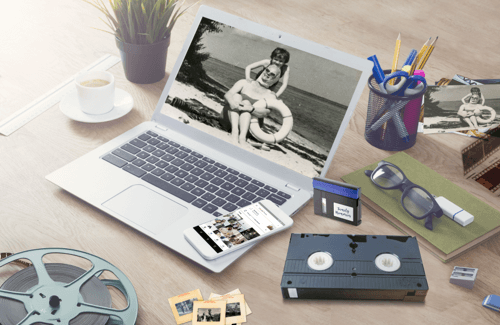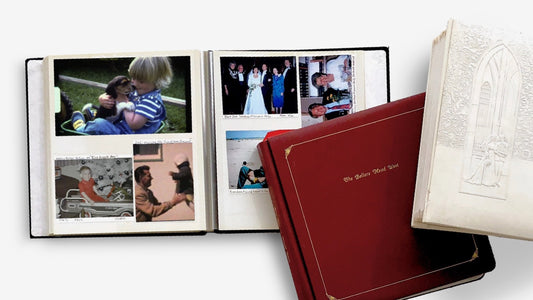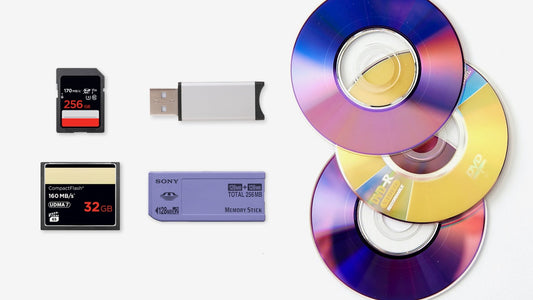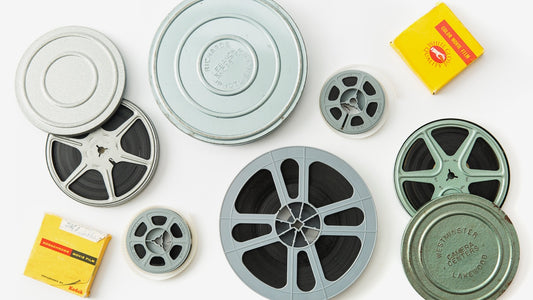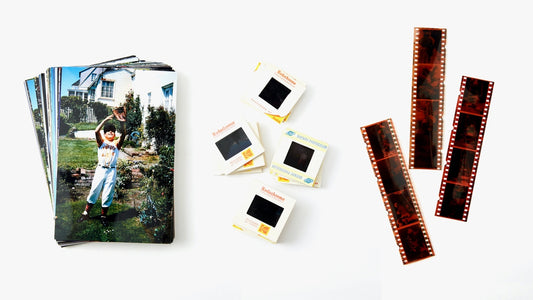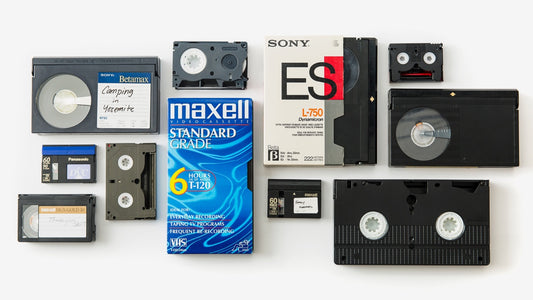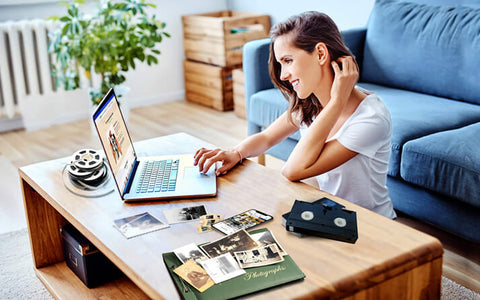That box of VHS tapes in your attic holds more than just magnetic tape; it holds your family’s history. Every birthday party, holiday gathering, and school play is waiting to be seen again. But those tapes are fading, losing a little bit of color and clarity with each passing year. Choosing to digitize them is the most important step you can take to protect those moments forever. The next crucial step is finding a partner you can trust with this precious job. This guide is designed to help you confidently choose the best vhs to dvd transfer service by comparing the top options on quality, security, and overall value.
Key Takeaways
- Digitize Now to Save Your Memories: The magnetic tape in your VHS collection is fragile and loses quality over time. Converting your tapes to a digital format is the only way to stop this natural decay and create a lasting copy that won't fade.
- Weigh Convenience Against Cost: A professional service offers the best quality and saves you time, making it a great investment for irreplaceable memories. The DIY route can save money if you're on a budget and enjoy a technical project, but be prepared for a steep learning curve and potentially lower-quality results.
- Organize Before, Back Up After: For a smooth process and easy-to-find files later, label your tapes with dates and events before sending them in. Once you get your digital files back, protect your investment by saving copies to both a cloud service and a physical hard drive.
Why Should You Convert Your VHS Tapes?
If you have a box of old VHS tapes tucked away in a closet or attic, you're sitting on a treasure trove of memories. Those tapes hold priceless moments: birthday parties, family vacations, school plays, and weddings. But here's the thing about those tapes—they weren't built to last forever. Converting them to a digital format is the best way to protect those memories and bring them back into your life.
The most urgent reason is simple: VHS tapes degrade over time. The magnetic tape inside the cassette is fragile and can break down, even if it’s just sitting on a shelf. After about 15 years, you can start to see a noticeable loss in quality, with colors fading and the picture becoming fuzzy. Every year that passes puts those irreplaceable moments at greater risk of being lost for good. Digitizing them creates a permanent copy that won't wear out.
Beyond preservation, think about how much easier it is to watch and share digital videos. Finding a working VCR these days can be a project in itself. Once your home movies are digitized, you can watch them on your computer, TV, or phone with a simple click. You can easily send a clip of your kid’s first steps to your sister across the country or create a highlight reel for a family reunion. This process is key to making them easy to enjoy and share with the people who matter most.
Finally, a professional video transfer service saves you time and ensures you get a high-quality result. While a DIY project is possible, it requires specific equipment and a lot of patience. Letting experts handle the conversion means you can be confident that your memories are being handled with care, giving you a beautiful digital keepsake you can cherish for generations to come.
The Best VHS to DVD Transfer Services
Choosing a service to handle your family's memories is a big decision. You're not just sending away old tapes; you're trusting someone with irreplaceable moments from birthdays, holidays, and everyday life. Those VHS tapes sitting in a box in the attic aren't getting any younger, and the magnetic tape inside degrades over time. Finding the right partner to digitize them means you can finally rescue those memories and share them with everyone you love, from your kids to your grandparents.
The goal isn't just to get a DVD in the mail. It's about getting a high-quality digital copy that you can easily watch, share online, and back up for safekeeping. The "best" service really depends on what matters most to you. Are you looking for the fastest turnaround time? Do you have a mix of media, like film reels and photo albums, that you want to digitize all at once? Or is your top priority knowing your tapes are being handled with the utmost care and security? Each company has its own strengths, so understanding them is key to making a choice you feel great about. To help you find the perfect fit, I’ve gathered the details on some of the most trusted names in the business. Let's walk through what each one brings to the table.
YesVideo
As a leader in the industry for over 20 years, YesVideo has built a reputation for trust and quality. When you use their video transfer service, you get more than just a DVD. They provide access to a private MemoryCloud account where you can view, download, and share your digitized videos with family and friends on social media or Google Photos. Every tape is processed by hand in the USA, giving you peace of mind that your memories are handled with care from start to finish. This is a fantastic option if you want an easy way to share your newly digitized memories online and store them securely.
Legacybox
Legacybox is a popular all-in-one option, especially if you have more than just VHS tapes to convert. They send you a box that you can fill with tapes, film reels, photos, and audio cassettes. This straightforward process helps you turn your old VHS tapes and other media into digital files you can easily watch and enjoy again. They provide step-by-step tracking throughout the process, so you always know where your memories are. Their service is designed to be simple and comprehensive, making it a great choice for anyone looking to digitize a whole collection of family history at once.
Costco Photo Center
If you're a Costco member, you might find their photo center to be a very accessible choice. They offer a convenient service for converting VHS tapes to DVDs and digital files. The familiarity and trust associated with the Costco brand make it a comfortable option for many families. You can simply drop off your tapes at a local store, which removes the hassle of packaging and shipping them yourself. This is ideal for anyone who values the ease of using a service they already know and trusts for other household needs, combining their memory preservation with a regular shopping trip.
Southtree
If the name Southtree sounds familiar, it’s because they are part of the same company as Legacybox. They offer a similar mail-in model for digitizing your home movies. You can expect a comprehensive service that handles your VHS tapes with care, converting them into modern digital formats. Because they share the same operational backbone as Legacybox, you can anticipate a streamlined process and reliable results. This gives you another solid choice for preserving your memories, especially if you're comparing features and pricing between the two sister brands to see which one better suits your specific project.
iMemories
iMemories is well-regarded for its high-quality transfers and easy-to-use process. They offer a user-friendly service that includes a free online gallery where you can view and organize your digitized videos before you even pay for the final downloads or DVDs. A standout feature is their mobile app, which makes it incredibly simple to watch your old home movies on your phone or tablet, wherever you are. This is a great fit for families who want a modern, tech-friendly way to access and enjoy their memories after they’ve been converted.
Capture
For those who are anxious about the turnaround time, Capture stands out by promising to complete your order in about 30 days. They emphasize their commitment to high quality, competitive pricing, and, most importantly, strong protection for your memories. They have developed a comprehensive tracking and processing system designed to keep your original tapes safe every step of the way. This focus on both speed and security makes Capture an appealing option for anyone who wants their digitized videos back quickly without compromising on the safety of their one-of-a-kind originals.
Forever Studios
Forever Studios is another great service that also acts as a helpful resource for customers. They provide a detailed comparison of different conversion services on their website, which can help you make a more informed decision. Their own service is known for its personal touch, offering options like custom video editing and personalized cases for your DVDs or USBs. This makes them a wonderful choice if you're looking for a more customized final product or if you want to do some extra research to feel confident you're choosing the absolute best service for your family's specific needs.
How to Choose the Right Service
Picking a company to handle your family's memories is a big decision. With so many options out there, it can be tough to know which one is the right fit. While price is a factor, it’s not the only thing that matters. You’re trusting someone with irreplaceable moments, so you want to be sure they’ll be treated with care. To make a confident choice, it helps to compare services based on a few key criteria. Looking at things like transfer quality, turnaround time, and security will help you find a service that not only fits your budget but also gives you peace of mind.
Think of it like choosing a babysitter for your kids—you want someone reliable, trustworthy, and skilled. The same goes for your memories. Before you pack up your tapes, take a moment to consider what’s most important to you. Is it getting the highest possible quality? Do you need them back by a specific date for a family event? Or is your top priority knowing they are safe and secure throughout the entire process? By breaking down the decision into smaller pieces, you can assess each service more clearly and find the one that aligns with your needs. This guide will walk you through what to look for, so you can find the perfect partner for preserving your home movies and photos.
Transfer Quality
The whole point of this project is to preserve your memories, so the quality of the final product is everything. Professional services almost always deliver a better result than a DIY setup because they use commercial-grade equipment and have technicians who know how to get the best picture and sound from old tapes. Before you commit, spend some time reading customer reviews and looking for examples of their work. Pay attention to what people say about the clarity and color of the final videos. A little research upfront ensures your digitized memories will be as vibrant as you remember them.
How Long It Takes
Digitizing tapes takes time, and the turnaround can vary quite a bit between companies. The standard process can take several weeks, as each tape is handled with care. If you’re working toward a deadline, like a family reunion or a milestone birthday, look for a service that offers expedited options. Many companies have rush processing for an additional fee, which can shorten the wait to just a few weeks or even days. It’s always a good idea to check the estimated timeline before you send your tapes in so you know exactly what to expect.
Keeping Your Tapes Safe
It’s completely normal to feel a little nervous about mailing your only copy of a precious memory. The best transfer services understand this and have invested in strong security and tracking systems to keep your tapes safe from the moment they leave your hands. Look for companies that process everything in-house rather than outsourcing it. At YesVideo, we process every order by hand at our own US-based facility, so you can be confident your memories are always in good hands. This commitment to security is a key part of our video transfer process.
Customer Support
When you’re dealing with something as personal as family memories, good customer support can make all the difference. You want a team that is easy to reach and ready to answer your questions. A great company will be transparent about its process and keep you updated on the status of your order. Reading reviews can give you a good sense of how a company treats its customers. Look for comments that mention helpful, responsive, and friendly support—it’s a sign that the company cares about making your experience as smooth and worry-free as possible.
Extra Features
Some services go beyond a simple transfer and offer extra features that make it easier to enjoy and share your memories. For example, many companies provide access to a private online viewing gallery where you can see your videos before you even get them back. YesVideo includes MemoryCloud access with every order, allowing you to view, download, and share your digitized files directly to platforms like Google Photos. These kinds of thoughtful extras can make one service stand out from the rest and add a lot of value to your experience.
What Format You Get
Once your tapes are digitized, you’ll need to decide how you want to receive the files. Most companies offer several options, including thumb drives, DVDs, or digital downloads from a cloud service. Think about how you plan to watch and share your videos. A thumb drive is great for plugging directly into a smart TV or computer, while a cloud link makes it easy to share with family members anywhere in the world. Choosing the right digital media transfer format ensures your memories are accessible and easy to enjoy for years to come.
Price and Overall Value
Pricing for VHS conversion can differ quite a bit, so it’s wise to get a clear idea of the total cost before you start. Some companies charge per tape, while others offer prepaid boxes that you can fill with a certain number of tapes, photos, or film reels. Be sure to check for any hidden fees, like shipping costs or charges for specific digital formats. Ultimately, the goal is to find the best overall value—a service that balances excellent quality, robust security, and helpful features at a price that feels right for you.
What Does It Cost to Convert VHS Tapes?
Figuring out the cost is a huge part of deciding how to digitize your VHS tapes. The price can vary quite a bit depending on whether you hire a professional service or tackle the project yourself. Let’s break down what you can expect to pay so you can find the best option for your budget and your precious memories.
Typical Service Pricing
When you start looking into professional services, you’ll find that prices generally fall between $20 and $30 per tape. Think of this as a baseline. The final cost often depends on the company's process, the quality of the equipment they use, and the care they take with your memories. For example, a service that provides detailed tracking and hand-processes every tape might be priced differently than a bulk processor. It’s always a good idea to check the company’s website for a clear breakdown of their video transfer pricing so you know exactly what you’re paying for.
Watch Out for Hidden Fees
The price per tape isn't always the final number. Some companies have extra charges that can catch you by surprise, so it pays to be a careful shopper. Look out for hidden fees like setup costs, extra charges for tapes longer than two hours, or fees for getting your files as a digital download instead of on a DVD. Before you commit, read the terms of service or reach out to customer support to ask for a complete cost estimate. Understanding the full pricing structure helps you avoid unexpected bills and choose a service that’s truly transparent.
DIY vs. Professional Costs
If you’re leaning toward a do-it-yourself project, your main expense will be the equipment. A good quality home converter can cost around $200, and you’ll also need a working VCR. If you have a lot of tapes, this one-time purchase can be more economical than paying a per-tape fee. However, the trade-off is your time and effort. Converting tapes yourself requires patience and a bit of technical comfort. Many people find the DIY approach rewarding, but it's important to weigh the cost against the convenience of having a professional service handle all the work for you.
Should You Use a Service or Do It Yourself?
Deciding how to convert your old VHS tapes is a big step. On one hand, you have professional services that handle everything for you. On the other, there’s the do-it-yourself route, which can be a rewarding project. The right choice really comes down to what you value most: convenience and quality, or cost savings and a hands-on experience. Think about how much time you have, your budget, and how comfortable you are with technology. Both paths can lead to digitized memories, but the journey to get there is quite different. Let's break down the pros and cons of each to help you figure out which approach is the perfect fit for you and your precious tapes.
The Pros and Cons of Using a Service
Handing your tapes over to a professional service is the most popular option for a reason: it’s simple and reliable. The biggest pro is the peace of mind you get from knowing experts are handling your memories. These services use high-end equipment that produces a much better quality transfer than most home setups can achieve. You also save a ton of time and avoid the headache of troubleshooting technical issues. Companies like YesVideo offer a complete video transfer that includes online viewing and sharing, making it easy to enjoy your memories right away. The main downside is the cost, as professional work is an investment. You also have to part with your tapes for a few weeks, but a trustworthy service will have tracking systems to keep them safe.
The Pros and Cons of a DIY Project
If you’re on a tight budget or love a good project, a DIY transfer can be a great option. The most significant advantage is the cost savings, especially if you have a large collection of tapes and already own a VCR. You get complete control over the process, from the equipment you use to the file format you choose. However, the DIY route has a steep learning curve. It takes a lot of time to convert each tape, and the quality can be a real gamble. According to some user discussions, cheap converters often produce disappointing results. There’s also a risk of damaging your fragile, aging tapes if you’re not careful.
Common DIY Tools and Techniques
Ready to try it yourself? You’ll need three key things: a working VCR, a computer, and an analog-to-digital video capture device to connect the two. Don't skimp on the capture device—it’s the most important part of the setup. Look for well-regarded models like the Hauppauge USB-Live2, which can deliver good quality without breaking the bank. You'll also need software to capture the video feed. Many people in the DIY community recommend using a program like VirtualDub because it’s designed for this kind of raw video capture. While it might be tempting to use something you’re already familiar with, like OBS Studio, it’s not ideal for this specific task and can lead to lower-quality files.
How to Decide: Service or DIY?
To make your final decision, ask yourself a few key questions. How valuable is your time? If you have dozens of tapes, a DIY project could take weeks or even months. How important is the final quality? If these are once-in-a-lifetime memories, a professional service ensures they look their best. Finally, how comfortable are you with technology? If troubleshooting drivers and software sounds like a nightmare, a service is the way to go. If your tapes are irreplaceable and you want guaranteed results for other media like old reels, a professional film transfer is your safest bet. But if you have the time, enjoy a technical challenge, and are working with a limited budget, the DIY approach can be a fulfilling experience.
What to Expect from the Transfer Process
Sending your precious memories off to be digitized can feel like a big step, but knowing what happens behind the scenes can make the entire experience feel much more comfortable and exciting. Think of it as sending your tapes on a spa day—they leave your home a bit dusty and dated, and they come back refreshed and ready for the future. Understanding the transfer process helps you appreciate the care that goes into it and gives you the confidence that you’re making the right choice for your family’s legacy.
The journey from a physical tape to a shareable digital file follows a few key stages, whether you use a professional service or do it yourself. It all starts with a little prep work at home to get your tapes ready. Then comes the main event: the conversion, where the analog footage is carefully captured and transformed into a digital format. After that, you’ll receive your new digital files, ready for viewing. Finally, there’s the quality check, ensuring the final product is a clear and stable representation of your original home movies. Each step is crucial for creating a lasting archive that you and your loved ones can enjoy for years to come. We’ll walk through exactly what to expect at each stage, so you feel informed and prepared.
How to Prepare Your Tapes
Before you pack up your tapes and send them on their way, a little preparation can go a long way in ensuring a smooth transfer. Start by gathering all your tapes in one place. Give each one a gentle wipe-down with a soft, dry cloth to remove any surface dust that’s collected over the years. If you can, try to label each tape with dates or a short description of the event—"Christmas '92," "Hawaii Vacation '95." This will make organizing your digital files so much easier later on. For tapes that have been sitting for a very long time, it’s a great idea to run them through a full fast-forward and rewind cycle in a VCR. This helps even out the tape tension and can prevent playback issues.
How a Professional Service Works
Once your tapes arrive at a professional facility, the real magic begins. A trained technician will carefully inspect each tape before placing it into professional-grade equipment. Unlike a standard home VCR, this gear is specifically designed to capture the best possible video and audio quality from older formats. The service then plays your tape in real-time, converting the analog signal into a digital file. At YesVideo, every video transfer is done by hand, ensuring your memories are handled with the utmost care from start to finish. This hands-on approach helps catch any potential issues and guarantees your tapes are treated as the irreplaceable treasures they are. It’s a meticulous process designed to honor the memories you’ve entrusted to them.
Getting Your New Digital Files
After the conversion is complete, you get to decide how you want to receive your newly digitized memories. Most services offer a few different options to fit your needs. You can have your files saved onto a USB thumb drive, which is great for plugging directly into a computer or smart TV. Another popular choice is DVDs, offering a classic and simple way to watch on a standard player. For the most flexibility, you can opt for cloud storage. With YesVideo’s MemoryCloud access, your memories are stored securely online, allowing you to view, download, and share them with family and friends from any device. Once your videos are safe, you can even start a new project, like an album scanning to bring your photo collection into the digital age too.
Checking the Quality
Quality is everything when it comes to preserving your family history. Professional services are dedicated to producing a clear and stable digital copy of your original footage. They use high-end equipment and specialized software to minimize common issues like tracking errors, shaky video, or color degradation that can happen with old tapes. While the final quality will always depend on the condition of the original VHS, a professional service has the tools and expertise to get the best possible result. Technicians monitor the transfer process from beginning to end, ensuring the final digital file is a faithful and lasting representation of your cherished home movies. You can rest easy knowing your memories are being captured with professional attention to detail.
Common Problems (And How to Solve Them)
When you’re dealing with tapes that are decades old, it’s natural to run into a few hiccups. You might be worried about tapes that look a little worse for wear or unsure about what the final quality will be. The good news is that most of these issues are common and have straightforward solutions, especially when you work with a professional service. Let’s walk through some of the typical problems you might face and how to handle them, so you can feel confident about preserving your precious memories.
What to Do with Damaged Tapes
If you’ve discovered tapes with mold, water damage, or a snapped ribbon, your first instinct might be to panic. Don't worry! This doesn't mean your memories are lost forever. Many professional services are equipped to handle these exact issues. They have experts who can carefully clean mold, repair broken casings, and splice snapped tape before beginning the digitization. While severe damage can sometimes be irreversible, it’s always worth having a professional assess the tape. A dedicated video transfer service has seen it all and has the tools to give your damaged tapes the best possible chance at a new digital life.
Understanding Quality Loss
It’s important to remember that VHS tapes were never meant to last forever. Over time, the magnetic tape degrades, leading to a gradual loss of color, sound, and picture clarity. This process can start after about 15 years, so the clock is ticking. Converting your tapes to a digital format is about preserving them in their current state before they degrade any further. The goal is to stop time, not reverse it. Your digital copy will be a faithful representation of the tape, so it won't look like a modern HD movie, but it will be safe from any future quality loss.
Solving Compatibility Problems
Did your family own a collection of different camcorders over the years? You might have a mix of formats like VHS, VHS-C, S-VHS, Betamax, or MiniDV. It can feel overwhelming to figure out what to do with all of them. Before you commit to a service or a DIY project, make sure you know what kind of tapes you have. A key benefit of using a professional service is that they can typically handle a wide variety of formats. Instead of you needing to find multiple different players, a company that specializes in digital media transfer can convert everything for you in one go.
What to Expect from Old Tapes
Setting realistic expectations is key to being happy with your final digital files. The quality of a VHS tape, even when it was brand new, is much lower than today’s standards. Most tapes from North America have a resolution of about 720x480. The final digital version will reflect this original quality. If you’re attempting a DIY transfer, the quality of your VCR and capture device will also play a huge role in the outcome. A professional service uses well-maintained, high-end equipment to ensure they capture the best possible signal from your tape, giving you a clear and stable digital copy of your memories.
How to Get the Best Possible Transfer
You’ve decided to digitize your tapes—that’s a huge step! Now, let's make sure the final result is as clear, vibrant, and organized as possible. Taking a few preparatory steps before you send your tapes off can make a world of difference in the quality and usability of your new digital memories. It ensures the process is smooth for the technicians and makes it easier for you to enjoy and share your videos later.
From simple organization to choosing the right format, here’s what you can do to ensure you get the best possible transfer of your cherished home movies.
Organize and Label Your Tapes
Before you pack everything up, take some time to gather all your tapes in one place. Go through them and, if you can, label each one with key information like the year, the event (e.g., "Christmas 1995," "Hawaii Vacation 2001"), and the people in the video. This doesn't have to be perfect, but even a little context helps. This simple step makes it much easier for you to identify and locate specific memories once they’re digitized. It also helps the transfer service keep your order organized and ensures every tape is accounted for.
Choose the Right Digital Format
The goal of converting your tapes is to make them accessible for years to come. When you use a professional video transfer service, you’ll typically get your memories back in a few different formats, including cloud access, a USB drive, or DVDs. A cloud-based option like YesVideo’s MemoryCloud is incredibly convenient because it allows you to view, download, and share your videos instantly from any device. You can even share them directly to social media or Google Photos, making it simple to send that classic family moment to the group chat.
Back Up Your Digital Files
Once your tapes are digitized, don't rely on a single copy. Technology can fail, so having backups is your best insurance policy for these irreplaceable memories. While cloud storage is a fantastic and convenient first step, you should also download the files and save them in at least one other location. This could be an external hard drive that you keep in a safe place or another personal cloud storage account. Think of it this way: you’re creating a digital master copy that you control, ensuring your memories are protected no matter what.
Think About Editing
Do you want to create a highlight reel from a wedding video or trim out the five minutes you accidentally recorded the floor? Some transfer services offer light editing features, but you can also use simple video editing software on your computer after you receive your digital files. Professional services generally produce a higher-quality initial transfer than you could achieve with a DIY setup, giving you a much better starting point for any edits you want to make. Getting a clean, stable digital file is the most important part of the process.
What to Do After Converting Your Tapes
Once your VHS tapes are digitized, you’ve successfully rescued your memories from fading away on old magnetic tape. This is a huge accomplishment, and it means your family’s stories are safe from the wear and tear of time. But the journey doesn't have to end there. Now that you have these digital files, you have the perfect opportunity to gather all your family's history in one safe, accessible place and share it with the people you love. Think of it as creating a digital family archive that everyone can enjoy for years to come. Instead of just another task on your to-do list, this next phase is all about bringing those memories back to life for a new generation.
Converting Other Types of Media
Chances are, your VHS collection was just one piece of your family's media puzzle. You might also have boxes of old 8mm film reels from your grandparents, stacks of photo albums from your childhood, or carousels full of slides from family vacations. Now that you've started, it's a great time to gather these other formats and get them digitized, too. Consolidating everything into a single digital library makes it so much easier to find and view your entire family history. Services that handle film transfer can convert those old reels, while others specialize in album scanning to preserve handwritten notes and photo arrangements exactly as they are.
How to Store and Share Your Digital Memories
Your newly digitized videos are precious, so it’s important to keep them safe. The best practice is to have at least two copies: one in the cloud and one on a physical device. You can upload your files to a cloud service like Google Photos or use the MemoryCloud access that often comes with a professional video transfer. For a physical backup, save the files to an external hard drive or a high-quality USB thumb drive that you store somewhere secure. Once they're backed up, the fun begins! You can easily share links with family members, create highlight reels for anniversaries or birthdays, and even host a virtual movie night to watch the old home movies together, no matter where everyone lives.
How to Make Your Final Decision
Okay, you’ve done the research and have a few contenders in mind. Making that final choice can feel like a big commitment, especially with irreplaceable memories on the line. The good news is that you have all the information you need to pick the right service with confidence. It really comes down to three final checks: clarifying what you need, seeing what other customers say, and finding the best value for your budget. Let’s walk through these last steps to get your project over the finish line.
Figure Out What You Need
Before comparing prices, take a final inventory. Are you only converting VHS tapes, or do you also have old film reels, photo albums, or slides? Some companies specialize, while others offer a comprehensive service for various formats. If you have a mixed collection, finding a service that handles everything in one order, like a video transfer and album scanning, saves a lot of hassle. Nailing down the full scope of your project helps you find a company that’s a perfect match, ensuring you don’t have to juggle multiple services.
Read Customer Reviews
Company websites highlight their best features, but customer reviews give you the real story. Look for feedback on things that matter most: communication, turnaround time, and final quality. For example, some services like Capture are often praised for their quality and security. On forums, you can find candid experiences, with users sharing things like, "I had a great experience with Capture... The cost was really reasonable as well." Look for patterns in the feedback to get a clear picture of what you can expect.
Look for Deals and Packages
Once you’ve narrowed down your choices to services that meet your quality standards, look for the best value. Keep an eye out for promotions, especially around holidays. Some companies offer significant discounts that make a big difference in the total cost. For instance, services like Legacybox sometimes run deals offering up to 50% off their digitizing kits. Signing up for a company’s email newsletter is a great way to get notified of these sales. Just remember to balance price with the features and security offered to ensure you’re getting the best overall value, not just the lowest price.
Related Articles
- Best VHS Video to Digital Converters: Top Picks – YesVideo
- 7 Best VHS to DVD Service Options for 2024 – YesVideo
- VHS to Digital Transfer: A Complete How-To Guide – YesVideo
- Digitize VHS Tapes: DIY or Pro? Expert Advice – YesVideo
- Transfer VHS to DVD: DIY or Pro - Which is Best? – YesVideo
Frequently Asked Questions
My tapes are over 20 years old and some look a bit rough. Is it even possible to save them? It’s completely normal for old tapes to show their age, but don't count them out just yet. While the magnetic tape does degrade over time, professional services are equipped to handle fragile and even slightly damaged tapes. They have the tools to clean, repair, and carefully digitize footage that you might think is lost for good. The most important thing is to act now to preserve the quality that remains before it degrades any further. It's almost always worth having an expert take a look.
What will the quality of my digitized videos be like? Will they look like they were filmed today? Your new digital files will be a faithful copy of what’s on the original VHS tape. The process is about preservation, not enhancement, so it won't magically transform your standard-definition home movies into modern HD footage. However, using a professional service ensures you get the best possible version of your memories. They use high-end equipment that captures a clearer, more stable picture than most home VCRs could, giving you a beautiful digital keepsake that’s safe from future decay.
I'm really anxious about mailing my only copies of these memories. How can I be sure they won't get lost? That feeling is completely understandable—these tapes are irreplaceable. Reputable transfer services know this and have built their entire process around keeping your memories safe. Look for companies that offer detailed, step-by-step tracking so you can follow your order's journey. Many top services, like YesVideo, also process every tape by hand in their own secure facilities right here in the US, which means your memories are never outsourced or unaccounted for.
Should I get my videos back on a DVD, a USB drive, or through the cloud? This really depends on how you want to watch and share your memories. DVDs are simple and familiar, while a USB drive is great for plugging directly into a smart TV or computer. For the most flexibility, a cloud-based option is fantastic. It gives you instant access to view, download, and share your videos with family and friends anywhere in the world. Many people find that a combination of cloud access for easy sharing and a physical USB for a personal backup is the perfect solution.
I found a mix of VHS tapes, old film reels, and photo albums. Do I need to use different services for each? You're in luck—you likely won't have to juggle multiple services. Many companies are set up to be a one-stop shop for all kinds of old media. Services that handle video transfers can often digitize film reels, photo prints, and entire photo albums in the same order. This makes it incredibly convenient to consolidate your entire family history into one organized digital library without the hassle of sending different formats to different places.





